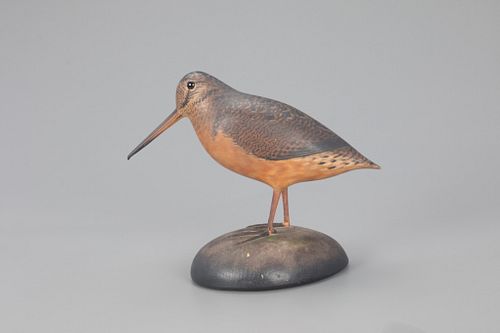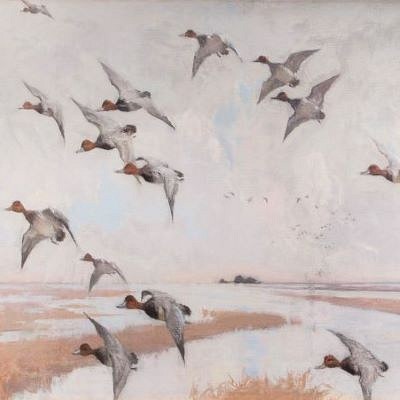Exceptional Early Woodcock, A. Elmer Crowell (1862-1952)
About Seller
20 Winter Street
Pembroke, MA 02359
United States
Founded in 2005, Copley Fine Art Auctions is a boutique auction house specializing in antique decoys and American, sporting, and wildlife paintings. Over the course of the last two decades, the firm has set auction records for not only individual decoy makers, but also entire carving regions. Copley...Read more
Two ways to bid:
- Leave a max absentee bid and the platform will bid on your behalf up to your maximum bid during the live auction.
- Bid live during the auction and your bids will be submitted real-time to the auctioneer.
Bid Increments
| Price | Bid Increment |
|---|---|
| $0 | $50 |
| $1,000 | $100 |
| $2,500 | $250 |
| $5,000 | $500 |
| $10,000 | $1,000 |
| $25,000 | $2,500 |
| $50,000 | $5,000 |
About Auction
Feb 19, 2021
Lots 1-292 Copley Fine Art Auctions cinnie@copleyart.com
- Lot Description
A. Elmer Crowell (1862-1952)
East Harwich, MA, c. 1912
During Elmer Crowell's youth, the landscape of the Cape was experiencing a regrowth of its forests. Before the arrival of Europeans, Native Americans lived in primarily pine and oak forests, with hickory, beech, cypress, red maple, and birch trees interspersed. Early colonial settlers vastly diminished these forests by cutting down trees in order to sustain themselves in their new land. Wood was used to build and heat homes, and the cleared land was utilized to grow food and graze livestock.
In the late 1800s, as the human population on the Cape declined, timber was no longer in such high demand and trees began to repopulate the landscape. This pattern of land use was beneficial to bobwhite quail, woodcock, and ruffed grouse that thrive in the mixed vegetation of an early-stage regrowth forest. Today these species are not commonly associated with Cape Cod; however, they were fairly abundant in Crowell's time." -Chelsie Olney and Stephen B. O'Brien Jr., -Elmer Crowell: Father of American Bird Carving
This carving represents not only one of the maker's earliest and best carvings of the species, but also his finest paint applications. A very closely related and possible mantel mate resided in the collection of top Crowell patron Dr. John H. Cunningham. Today, the Cunningham example, which also features rarely seen carved wooden legs, resides in one of the country's top decorative collections.
While Crowell often utilized metal legs for his upland and shorebirds, this early example exhibits carved wooden legs. The authors of "Elmer Crowell: Father of American Bird Carving" explain, "In the case of his decorative carvings on wooden bases, Crowell experimented with different techniques for creating legs, eventually discovering that umbrella stays, with their thin diameter yet great strength, provided the best stability."
This early decorative woodcock bears the maker's crisp oval brand on the underside of its carved wooden base. The grand body is outfitted with a bill which displays precise incised mandible carving and a curvature to the very tip of the bill. The timberdoodle's complex plumage is masterfully applied with tight feathering and soft blending.
Excellent original paint with minimal wear, minor chipping at feet insertion and one missing spur.
Provenance: Private Collection, acquired from the maker
Private Collection, Massachusetts, acquired from the family of the above
Literature: Brian Cullity, The Songless Aviary: The World of A. E. Crowell & Son, Hyannis, MA, 1992, p. 86. Stephen B. O'Brien Jr. and Chelsie W. Olney, "Elmer Crowell: Father of American Bird Carving," Hingham, MA, 2019, pp. 15, 16 related carvings illustrated, p. 193 makers leg treatment discussed. Robert Bishop, "American Folk Sculpture," New York, NY, 1985, p. 181, pl. 332, related example illustrated. Richard A. Bourne, Inc. Rare American Decoys, Bird Carvings, Miniature, and Related Items, August 1, 1972, lot 142, closely related example illustrated.Please email condition report requests to colin@copleyart.com. Any condition statement given is a courtesy to customers, Copley will not be held responsible for any errors or omissions. The absence of a condition statement does not imply that the lot is in perfect condition.Condition
- Shipping Info
-
Copley Fine Art Auctions does not handle the shipping of any items. Shipping is the sole responsibility of the buyer. Once your payment has cleared and we have received your shipping form, items may be released for shipment. Copley Fine Art Auctions, LLC shall have no liability for any loss or damage to such items. Buyers should allow up to four weeks for shipment.
Please be aware that internet bidders may NOT not pick up their items at the sale. Items will be available for pick up by appointment or by shippers five days after the sale.
-
- Buyer's Premium



 EUR
EUR CAD
CAD AUD
AUD GBP
GBP MXN
MXN HKD
HKD CNY
CNY MYR
MYR SEK
SEK SGD
SGD CHF
CHF THB
THB
















